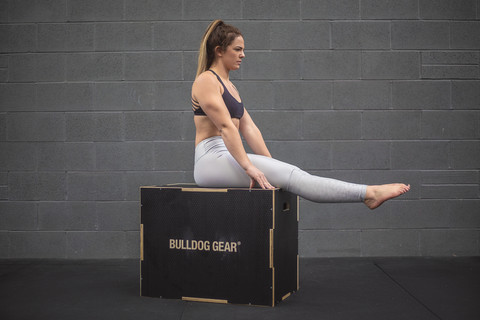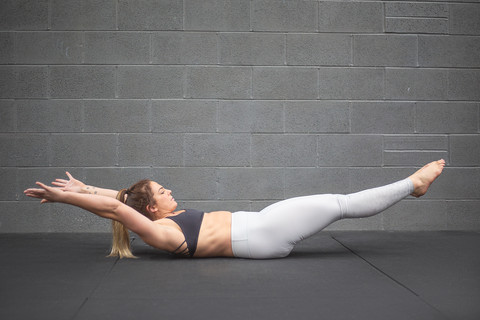Progressions & Regressions || L-Sits
- Georgie Gabriel

- Aug 25, 2020
- 7 min read


Building strength in an L-Sit will help build a functionally strong core and stable shoulders, whether you’re practising the hanging or holding variation. Using these strengths and transferring them into other areas of your training proves to be hugely beneficial. You’ll develop a more stable trunk in addition to improving hip and spine stability. Adding L-Sits into your workout sessions will help towards achieving your goals, whether that's in your yoga practice, handstands, lever variations in your gymnastics and calisthenics or being able to lift more in your weight training.
I remember trying an L-Sit hang for the first time after my coach demonstrated it so easily and thinking, “that looks alright!”. I jumped on the rig, used some momentum to raise my legs up, which then dropped straight back down as as fast as I’d lifted them up. I felt instant cramp in my quads and my hips ached. Getting my whole body to connect in this movement felt impossible. I’m still no master of the L-Sit hang or hold but I frequently add them in to my training. I’m currently working towards some of the progressions mentioned myself to build strength and help achieve my own personal goals.

Hamstring Flexibility
Sit on the ground. Can you sit up tall at 90 degrees with your legs straight out in front of you? Can you hold yourself there comfortably without the hamstrings screaming at you? If so, then your passive hamstring flexibility most likely isn’t an issue. You don't need to be able to get your chest all the way to your thighs in a full fold to be able to do an L-Sit, but if you can sit at 90 degrees comfortably then you're pretty good to go.
To work on your hamstring flexibility you could sit on the edge of an ab mat to help tilt the pelvis more anteriorly so you can work deeper into the fold. You can also bend your knees when folding to avoid overly rounding your back.
Hip Flexor Strength
Sit up tall with your legs out in front. Can you sit tall without the use of your hands and without feeling like you're going to fall backward? If so, you have the basic hip flexor strength required to get in to an L-sit. However, if you slump backward or really struggle to sit up in this position it’s likely you need to work a little more on your hip flexor strength.
We can improve our hip flexor strength in many ways, such as supported leg raises using the dip attachment, pull-up bars or ring supported (to challenge stability). We can sit at 90 degrees and do seated single leg raises or double leg raises known as compression sits, elevate your hips here on box, ab mats or bench if you struggle on the floor. We can also perform standing single leg raises or holds. Any variation that holds one or both legs straight out in front of you will help condition the hip flexors and body ready for an L-Sit.
We need to teach our bodies to get used to the feeling in the quads too, rather than always opting for tucks. As we raise the legs up, we want to compress the body actively. When doing supported leg raises or compression sits, the more you lean forward, the harder it’ll feel as you’ll compress more and this will be more beneficial. Make sure you avoid swing the legs. If you find yourself leaning back, then try sitting in front of an upright or against the wall while actively trying to compress the body forward instead.
KIT NEEDED FOR THIS MOVEMENT
There are two variations of L-Sits:
L-Sit Hold
For the hold we need to push down into the parallettes without shrugging the shoulders. We use predominantly the anterior chain or front of the body. These can be done tucked, single leg extensions or with both legs extended.

KIT NEEDED FOR THIS MOVEMENT
L-Sit Hang
For the hang we actively pull with straight arms, engaging the lats. We use the anterior chain but also the posterior chain during this movement. These can be done tucked, single leg extensions or both legs extended.

KIT NEEDED FOR THIS MOVEMENT


The Boat pose, also known as Navasana in Yoga, is a great place to start engaging the anterior chain of the body. There are several regression levels. Start by sitting up tall with knees bent and hold on to the backs of the thighs. Bring your ankles in line with your knees. From here you can let go of the legs. To challenge yourself further try extending one or both of your legs. This will help to strengthen the core, hip flexors and get the quads used to being in a straight leg hold. Focus on breathing in and out of the nose and keep the chest tall while trying to compress the body close to the thighs.

The further we take our legs from the midline, the harder it is for us to control and maintain the shape we’ve created. More variables are at play and the stress on the body is greater. The tuck is a great way to make that shape smaller if, for now, extending the legs is too much. To challenge yourself further in a tuck, add weight by balancing a bumper plate onto your thighs.

KIT NEEDED FOR THIS MOVEMENT

This is one of my favourite variations because the band takes away some of the load, meaning you’re working at a percentage of your body weight, while also conditioning the quads and hip flexors during the full L-Sit. At the start we may try to progress from a tuck to a straight leg hold and immediately experience cramp. The resistance bands will help your body to withstand being held while your legs are in a contracted position. Keep the feet above the hip crease and keep compressing the body forward. Try not to shrug the shoulders. You can go as thick as you need with the bands and gradually over time start to take them away or decrease the resistance.

KIT NEEDED FOR THIS MOVEMENT

Compression sits will strengthen the anterior chain, hip flexors and quads, which will help prepare you for L-Sits. The further forward you move your hands, the more compressed your body is and the harder the movement. Place your fingertips by your hips and raise your legs together. Shuffle your hands forward and see how far you can maintain lifting the feet off the ground. We can also do single leg variations. If you’re unable to perform this movement without leaning back then use the wall or a rig upright.

Stand in front of a wall, point one foot forward and raise the leg up and down to work through the hips. Add in isometric holds at the top too.This is also a great way to discover imbalances between sides and gradually work to balance them out. I recommend always starting on the weaker side first.

Hanging, dip attachment or ring elevated leg raises will help dynamically strengthen the range of motion in the hips, midline and shoulders required for the L-Sit, whilst also conditioning the anterior body. Avoid swinging the legs and using momentum. You can do these tucked, one leg extended as well as both legs extended.
KIT NEEDED FOR THIS MOVEMENT

This is more of a regression for the compression sits. You could also use ab mats here and just elevate the hips a little. By using a higher platform, it enables us to raise our legs as we compress forward more easily if we’re struggling on the floor, which will help in our hip and core strength.
KIT NEEDED FOR THIS MOVEMENT

Dead Bugs - This is one of my favourite exercises to build stability in the trunk of the body, as well as improving your coordination. Keep the head on the ground, the hands above shoulders, knees above hips and ankles in line with knees. Compress and push the lower back down to the ground. You can stay in this position to build static strength or take one leg and the opposite arm and extend them at the same time. The more you extend them out the harder you have to work to keep the lower back connected to the ground. Keep drawing the rib cage down and avoid it faring out.
Hollow Holds - Leading on from the dead bug we can take both arms and legs away from the midline. Pin the lower back, but this time raise the head and shoulder blades up off the floor. The whole body is connected in this movement. If you feel the lower back peeling off the ground immediately tuck one leg in, both and even extend arms out by the hips. This movement will build strength in the whole chain.
Down Dog Toe Taps - This is a tough one for the hamstrings if they’re tight. The hips are flexed and as you draw the foot to your arm it requires a deep compression. Get into a downward dog position, now try to reach one foot the hand on the same side. Repeat on the other side.


Once you’ve built up to a decent 20-30 second L-Sit hold try adding some load, by either wearing a weight vest or by balancing a fractional plate on top of your feet. You could then break your holds down into smaller increments, such as 10 seconds. The added load will help build more strength as your body works harder to stabilise more weight than it’s used to.

KIT NEEDED FOR THIS MOVEMENT

Strengthen up a larger range of motion by adding this challenging variation. Perform an L-Sit hold, now with control and keeping your arm straight continue compressing the body as you raise the legs further, touching the pull-up bar with your feet and then slowly take them back to the L-Sit hold again. This requires your hips to remain in a flexed position and demands a great deal of strength, control, awareness and compression. You could also hang from the rings and perform and L-Sit into a Skin-the-cat.
KIT NEEDED FOR THIS MOVEMENT

Try an L-Sit overhand or underhand pull-up. The overhand will feel harder due to requiring more posterior chain engagement whilst keeping the front of the body in an active static position. The underarm pull-up will feel easier since it uses more of the anterior recruiting the biceps in the pull. Try both and add these in to your training, you can also challenge it further by adding external load like a weight vest. These can also be performed during a legless rope climb by sitting in pike or straddle and using the upper body to climb the rope, whilst keeping the toes above the crease of the hips.
KIT NEEDED FOR THIS MOVEMENT

This is a far deeper compression and tests your strength by taking the body into the shape of a V instead of an L. You need to be able to bring the hips much further forward, compressing your pelvis toward your sternum. This will require more hamstring flexibility, as well as a whole lot of patience.


- Georgie Gabriel

































































Comments